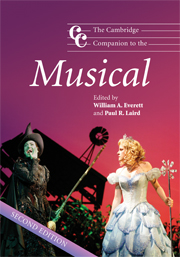Book contents
- Frontmatter
- Part I Adaptations and transformations: before 1940
- Part II Maturations and formulations: 1940–1970
- 7 ‘We said we wouldn't look back’: British musical theatre, 1935–1960
- 8 The coming of the musical play: Rodgers and Hammerstein
- 9 The successors of Rodgers and Hammerstein from the 1940s to the 1960s
- 10 Musical sophistication on Broadway: Kurt Weill and Leonard Bernstein
- Part III Evolutions and integrations: after 1970
- Part IV Legacies and transformations
- Notes
- Select bibliography
- Index
8 - The coming of the musical play: Rodgers and Hammerstein
from Part II - Maturations and formulations: 1940–1970
Published online by Cambridge University Press: 28 September 2011
- Frontmatter
- Part I Adaptations and transformations: before 1940
- Part II Maturations and formulations: 1940–1970
- 7 ‘We said we wouldn't look back’: British musical theatre, 1935–1960
- 8 The coming of the musical play: Rodgers and Hammerstein
- 9 The successors of Rodgers and Hammerstein from the 1940s to the 1960s
- 10 Musical sophistication on Broadway: Kurt Weill and Leonard Bernstein
- Part III Evolutions and integrations: after 1970
- Part IV Legacies and transformations
- Notes
- Select bibliography
- Index
Summary
Broadway was an exciting place to be in the 1920s, as many new voices were heard in American musical theatre. One important voice was that of jazz; other new voices included the composers George Gershwin, Vincent Youmans, Arthur Schwartz, Ray Henderson and, of course, the team of Richard Rodgers and Lorenz Hart. Rodgers (1902–79) and Hart (1895–1943) began their twenty-five-year collaboration during college productions at Columbia University. Their professional productions began with Poor Little Ritz Girl in 1920, and they attracted considerable critical and popular attention with their hit song ‘Manhattan’ in The Garrick Gaieties in 1925. By the end of the 1920s, several more of their shows had appeared on Broadway: Dearest Enemy (1925); The Girl Friend, a second The Garrick Gaieties, Peggy-Ann and Betsy (1926); A Connecticut Yankee (1927); She's My Baby, Present Arms and the disastrous failure Chee-Chee (1928); and Heads Up! (1929). By the end of the decade Rodgers and Hart counted among the most popular songwriters in America, but after the start of the Depression and with the arrival of sound in motion pictures, they turned to the promising opportunities of writing film scores in Hollywood.
Hollywood proved to be financially rewarding, and Rodgers and Hart created some of their most enduring songs for films produced in the early to mid-1930s, such as ‘Isn't It Romantic’, ‘You Are Too Beautiful’, and ‘Easy to Remember’. However, the waiting game of writing a few songs for a film over which they had little artistic control was not for this energetic pair. They returned to Broadway in 1935 with Jumbo, an extravaganza staged by Billy Rose. The 233 performances of Jumbo began a five-year series of hit shows for Rodgers and Hart, and at one point they had three shows running simultaneously.
- Type
- Chapter
- Information
- The Cambridge Companion to the Musical , pp. 147 - 163Publisher: Cambridge University PressPrint publication year: 2008



